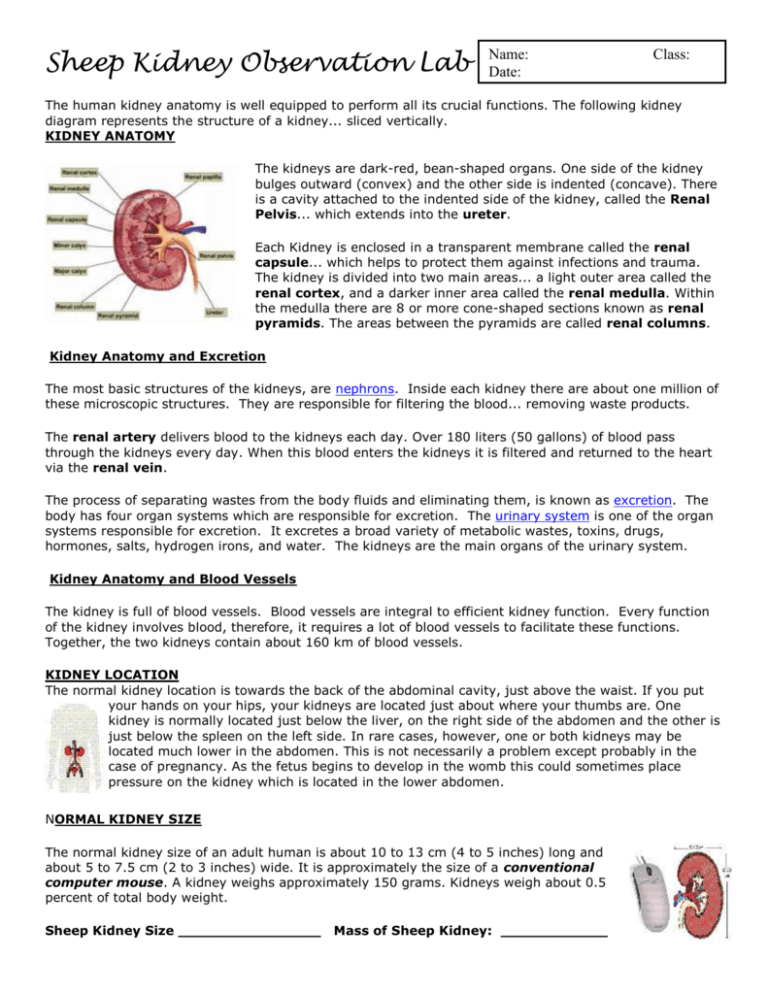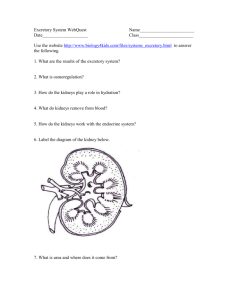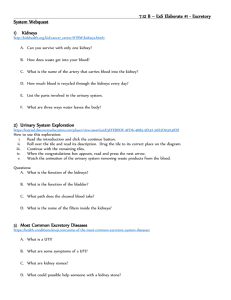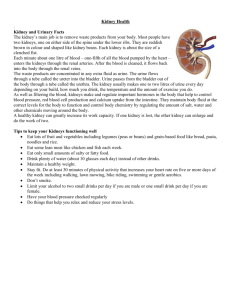Sheep Kidney Observation Lab
advertisement

Sheep Kidney Observation Lab Name: Class: Date:_________________________ _ The human kidney anatomy is well equipped to perform all its crucial functions. The following kidney diagram represents the structure of a kidney... sliced vertically. KIDNEY ANATOMY The kidneys are dark-red, bean-shaped organs. One side of the kidney bulges outward (convex) and the other side is indented (concave). There is a cavity attached to the indented side of the kidney, called the Renal Pelvis... which extends into the ureter. Each Kidney is enclosed in a transparent membrane called the renal capsule... which helps to protect them against infections and trauma. The kidney is divided into two main areas... a light outer area called the renal cortex, and a darker inner area called the renal medulla. Within the medulla there are 8 or more cone-shaped sections known as renal pyramids. The areas between the pyramids are called renal columns. Kidney Anatomy and Excretion The most basic structures of the kidneys, are nephrons. Inside each kidney there are about one million of these microscopic structures. They are responsible for filtering the blood... removing waste products. The renal artery delivers blood to the kidneys each day. Over 180 liters (50 gallons) of blood pass through the kidneys every day. When this blood enters the kidneys it is filtered and returned to the heart via the renal vein. The process of separating wastes from the body fluids and eliminating them, is known as excretion. The body has four organ systems which are responsible for excretion. The urinary system is one of the organ systems responsible for excretion. It excretes a broad variety of metabolic wastes, toxins, drugs, hormones, salts, hydrogen irons, and water. The kidneys are the main organs of the urinary system. Kidney Anatomy and Blood Vessels The kidney is full of blood vessels. Blood vessels are integral to efficient kidney function. Every function of the kidney involves blood, therefore, it requires a lot of blood vessels to facilitate these functions. Together, the two kidneys contain about 160 km of blood vessels. KIDNEY LOCATION The normal kidney location is towards the back of the abdominal cavity, just above the waist. If you put your hands on your hips, your kidneys are located just about where your thumbs are. One kidney is normally located just below the liver, on the right side of the abdomen and the other is just below the spleen on the left side. In rare cases, however, one or both kidneys may be located much lower in the abdomen. This is not necessarily a problem except probably in the case of pregnancy. As the fetus begins to develop in the womb this could sometimes place pressure on the kidney which is located in the lower abdomen. NORMAL KIDNEY SIZE The normal kidney size of an adult human is about 10 to 13 cm (4 to 5 inches) long and about 5 to 7.5 cm (2 to 3 inches) wide. It is approximately the size of a conventional computer mouse. A kidney weighs approximately 150 grams. Kidneys weigh about 0.5 percent of total body weight. Sheep Kidney Size ________________ Mass of Sheep Kidney: ____________ How does the sheep kidney size and mass compare to an adult human kidney? Internal Kidney Structures Using the sheep kidney specimens, locate each of the following internal parts of the kidney and color-code them with the labels to the right. Now raise your hand and have your teacher come over and let you identify these parts on the specimen: Teacher initials: Identify that Value! Fill in the left hand column with the terms/values from the list: 15%; thirst; 66%; 80%; kidneys; hypothalamus The proportion of the body’s water found within the cells The part of the brain concerned with controlling water balance The proportion of the body’s water an animal will not survive losing This is the main mechanism for diluting the blood The proportion of an animal’s body that consists of water These organs are important for controlling water balance MATH CHALLENGE (Show your Work!) The kidneys are almost as busy as the heart! They process 45 liters of blood per day and remove about 1.5 liters of waste per day. Over a lifetime that can really start to add up. 1) What if you wanted to find out how many liters of blood the kidneys processed in one year? 2) What if you wanted to find out how many liters of waste the kidneys removed in one year? 3) What if you lived to be one hundred years old? How many liters of blood will your kidneys have processed? 4) What if you lived to be one hundred years old? How many liters of waste will your kidneys have removed? Review Questions - Answer in complete sentences. 1. What are the two primary functions of the kidneys? 2. Which blood vessel, the renal artery or renal vein contains less nitrogenous wastes such as urea? Explain why. 3. Which blood vessel, the renal artery or renal vein carries more oxygen? Explain why. 4. What do you think is the function of the adipose tissue around the kidney? 5. What structure allows the urine to flow from the kidney to the urinary bladder?







